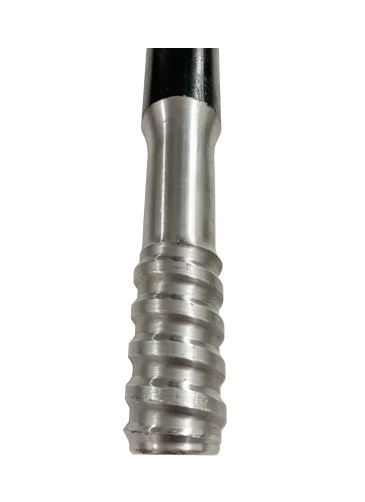วัสดุขั้นสูงใน แท่งเจาะ การก่อสร้าง
องค์ประกอบโลหะผสมความแข็งแรงสูง
โลหะผสมที่มีความแข็งแรงสูงได้เปลี่ยนวิธีการสร้างแกนสว่านของเราไปโดยสิ้นเชิง ทำให้แกนสว่านทนทานมากขึ้นและมีสมรรถนะที่ดีขึ้นเมื่อถูกใช้งานจนถึงขีดจำกัด ตัวอย่างเช่น โลหะผสมนิกเกิล-โครเมียม และแมงกานีส-ซิลิคอน ต่างก็นำคุณสมบัติที่โดดเด่นเฉพาะตัวมาสู่การผลิต วัสดุเหล่านี้มีสมรรถนะเหนือกว่าทางเลือกแบบดั้งเดิมอย่างชัดเจนในแง่ของการต้านทานการสึกหรอและการใช้งานระยะยาว นิกเกิล-โครเมียมโดดเด่นเป็นพิเศษในการทนต่อการกัดกร่อนและความร้อนได้ดีเยี่ยม ซึ่งเป็นคุณสมบัติที่สำคัญมากในสภาพการทำงานใต้ดินที่มักมีอุณหภูมิสูงขึ้นอย่างรวดเร็ว ในขณะที่แมงกานีส-ซิลิโคนก็มอบความแข็งแรงทนทานต่อแรงดึงได้อย่างยอดเยี่ยม ตามข้อมูลภาคสนามล่าสุดจากหลายพื้นที่เจาะสำรวจในอเมริกาเหนือ บริษัทต่างๆ รายงานว่ามีแกนสว่านหักหรือเสียหายลดลงประมาณ 30% นับตั้งแต่เปลี่ยนมาใช้วัสดุที่แข็งแรงขึ้นเหล่านี้ หมายความว่ามีเวลาหยุดทำงานลดลงและค่าใช้จ่ายในการเปลี่ยนทดแทนต่ำลง สำหรับผู้ปฏิบัติงานที่ต้องการยืดอายุการใช้งานของอุปกรณ์โดยไม่ลดทอนมาตรฐานความปลอดภัย การลงทุนในวัสดุขั้นสูงเหล่านี้คือสิ่งที่สร้างความแตกต่างอย่างแท้จริงในการดำเนินงานประจำวัน
นวัตกรรมแทรกคาร์ไบด์สำหรับการยืดอายุการใช้งาน
การพัฒนาใหม่ในเทคโนโลยีเม็ดกลมคาร์ไบด์ได้เพิ่มอายุการใช้งานของแท่งเจาะให้ยาวนานขึ้นมาก ซึ่งช่วยให้การดำเนินงานราบรื่นขึ้นและยังช่วยประหยัดค่าใช้จ่ายอีกด้วย ตัวอย่างเช่น การออกแบบคาร์ไบด์หลายชั้นใหม่นี้ มีความทนทานต่อการสึกกร่อนได้ดีกว่ารุ่นเก่ามาก มีการทดสอบบางอย่างแสดงให้เห็นว่าเม็ดกลมใหม่นี้มีอายุการใช้งานยาวนานกว่าประมาณ 20 เปอร์เซ็นต์ในสภาพแวดล้อมที่ควบคุม เมื่อสว่านมีอายุการใช้งานที่ยาวนานขึ้นระหว่างการเปลี่ยนเม็ดกลม ก็จะช่วยลดเวลาที่อุปกรณ์ต้องหยุดทำงานและค่าใช้จ่ายในการซ่อมแซม บริษัทที่ทำการเจาะจึงได้รับประโยชน์อย่างมาก เพราะสามารถทำงานให้เสร็จได้เร็วขึ้น โดยไม่ต้องเสียค่าใช้จ่ายจำนวนมากในการเปลี่ยนเครื่องมือที่สึกหรอ นวัตกรรมเหล่านี้ในเทคโนโลยีคาร์ไบด์ถือเป็นความก้าวหน้าที่สำคัญในการเพิ่มประสิทธิภาพของการดำเนินงานด้านการเจาะในอุตสาหกรรมโดยรวม
วิศวกรรมความแม่นยำสำหรับความสามารถในการเจาะ 360 องศา
ความสามารถในการปรับมุมของเครื่องเจาะ Webdrill MCR
สิ่งที่ทำให้ Webdrill MCR Rig โดดเด่นคือความสามารถในการเจาะได้ทุกทิศทางโดยไม่มีข้อจำกัด กลไกการหมุนอันชาญฉลาดของตัวเครื่องช่วยให้ผู้ควบคุมสามารถเข้าถึงจุดต่าง ๆ ได้แม้ในขณะที่ต้องซ่อมแซมชิ้นส่วน โดยไม่จำเป็นต้องถอดโครงสร้างบูมทั้งหมดออกขณะซ่อมบำรุง ซึ่งหมายความว่าใช้เวลารอคอยในการบำรุงรักษาน้อยลง ช่วยประหยัดค่าใช้จ่ายและทำให้โครงการดำเนินไปอย่างต่อเนื่อง สถานที่ทำเหมืองมักพบกับชั้นหินและสภาพพื้นดินที่หลากหลาย การสามารถปรับมุมการเจาะได้แบบเรียลไทม์จึงช่วยให้ผ่านจุดที่มีความยากเป็นพิเศษได้อย่างมีประสิทธิภาพ ผลจากการทดสอบจริงแสดงให้เห็นว่า เครื่องจักรรุ่นนี้สามารถลดเวลาการเจาะได้ประมาณ 25% เมื่อเทียบกับรุ่นเก่า ซึ่งการประหยัดเวลาในระดับนี้มีความสำคัญมากเมื่อทำงานในพื้นที่ขนาดใหญ่ นอกจากนี้ ความแม่นยำของระบบยังช่วยลดข้อผิดพลาดและวัสดุสูญเสียระหว่างกระบวนการขุดเจาะ สำหรับบริษัทที่ทำงานในพื้นที่ที่สภาพแวดล้อมไม่แน่นอน ทุกชั่วโมงมีความสำคัญ และวิศวกรรมในระดับนี้คือสิ่งที่ทำให้สามารถทำงานทันตามกำหนดเวลา หรืออาจจะล้าหลังได้
ประสิทธิภาพของระบบ Rockmore Vector Rod
ระบบ Vector Rod ของ Rockmore โดดเด่นอย่างมากในแง่ของการทำให้การดำเนินการเจาะเป็นไปอย่างรวดเร็วและมีประสิทธิภาพมากยิ่งขึ้น สิ่งที่ทำให้ระบบนี้มีความพิเศษคือการที่มันถูกออกแบบมาโดยเฉพาะสำหรับการใช้งานด้านการเจาะ ผลการทดสอบภาคสนามแสดงให้เห็นว่าความเร็วในการเจาะเพิ่มขึ้นประมาณ 15% เมื่อใช้ระบบนี้ ในขณะที่การบริโภคน้ำมันเชื้อเพลิงลดลงราว 10% เมื่อเทียบกับรุ่นเก่า โครงสร้างของ Vector Rods ถูกออกแบบมาเพื่อเพิ่มประสิทธิภาพดังกล่าวโดยเฉพาะ ไม่เพียงแต่ช่วยลดเวลาที่ต้องใช้ในบริเวณสถานที่เจาะบ่อน้ำมันเท่านั้น แต่ยังช่วยลดการใช้พลังงานโดยรวมอีกด้วย สำหรับผู้ปฏิบัติงานด้านการเจาะที่ต้องการลดต้นทุนในงบประมาณของตน สิ่งปรับปรุงเช่นนี้มีความสำคัญอย่างมาก บริษัทที่เปลี่ยนมาใช้ระบบของ Rockmore มักจะเห็นการลดลงของต้นทุนการดำเนินงานอย่างชัดเจน ซึ่งหมายความว่าโครงการต่าง ๆ จะเสร็จสิ้นเร็วขึ้นและมีค่าใช้จ่ายน้อยลงกว่าที่ผ่านมา ทำให้บริษัทเหล่านั้นได้รับความได้เปรียบเหนือคู่แข่งในอุตสาหกรรมที่ทุกๆ ดอลลาร์ที่ประหยัดได้มีความหมายอย่างยิ่ง
ระบบการจัดแนวอัตโนมัติสำหรับความแม่นยำที่เหนือกว่า
เทคโนโลยีการจัดแนวอะซิมัทของ Minnovare
ตัวปรับแนวอะซิมุท Minnovare เป็นสิ่งที่ทำให้การเจาะแนวตรงมีความแม่นยำมากขึ้น เทคโนโลยีนี้ช่วยทำให้กระบวนการปรับแนวแท่นเจาะทั้งหมดเป็นระบบอัตโนมัติ ซึ่งหมายความว่ามีความแม่นยำที่ดีกว่าและทำงานได้เร็วขึ้นในสถานที่ก่อสร้าง ผลจากการทดสอบภาคสนามนั้นค่อนข้างน่าประทับใจ — ข้อผิดพลาดในการปรับแนวลดลงประมาณ 90% เมื่อเปรียบเทียบกับการใช้วิธีการปรับแนวแบบดั้งเดิม ซึ่งแทบจะขจัดการต้องเจาะซ้ำอีกครั้งอันเนื่องมาจากความผิดพลาดต่าง ๆ เมื่อโครงการแล้วเสร็จได้เร็วขึ้นด้วยความแม่นยำที่เพิ่มขึ้นนี้ ทรัพยากรต่าง ๆ ก็ถูกนำไปใช้ได้อย่างมีประสิทธิภาพมากยิ่งขึ้น นอกจากนี้ยังมีเวลาที่เสียไปกับการตั้งค่าอุปกรณ์ลดลง และค่าใช้จ่ายที่เกี่ยวข้องกับการหยุดทำงานก็ลดลงตามไปด้วย โดยเฉพาะในงานเหมืองแร่แล้ว สิ่งนี้ช่วยประหยัดค่าใช้จ่ายได้จริง และทำให้กระบวนการดำเนินงานราบรื่นขึ้นตั้งแต่ต้นจนจบ
การควบคุมคอและมุมเอียงแบบขับเคลื่อนด้วยเซนเซอร์
ระบบเซ็นเซอร์ทันสมัยสำหรับการควบคุมการเจาะและมุมเอียงกำลังเปลี่ยนวิธีการทำงานของการเจาะบ่อน้ำมันด้วยคุณสมบัติอัตโนมัติ ระบบที่ติดตั้งไว้จะตรวจสอบสภาพการทำงานตลอดเวลา และปรับมุมเอียงของการเจาะโดยอัตโนมัติ ซึ่งเท่ากับว่าทำหน้าที่แทนขั้นตอนที่เคยต้องปรับด้วยมือในอดีต จากรายงานภาคสนามของผู้ดำเนินการหลายคน ระบุว่าการใช้งานระบบอัตโนมัติช่วยลดข้อผิดพลาดในการตั้งตำแหน่งได้ประมาณ 30% และทำให้การวางตำแหน่งบ่อน้ำมันแม่นยำขึ้น ความแม่นยำที่เพิ่มขึ้นช่วยให้การเจาะดำเนินไปอย่างรวดเร็ว และลดการแก้ไขที่ก่อให้เกิดค่าใช้จ่ายสูงตามมา นอกจากนี้ยังมีความเสี่ยงลดน้อยลง เนื่องจากปัญหาที่อาจเกิดขึ้นถูกระบุตัวตนตั้งแต่แรกเริ่ม ก่อนที่จะลุกลามจนกลายเป็นปัญหาใหญ่ บริษัทเจาะบ่อน้ำมันหลายแห่งรายงานว่าพวกเขามีความมั่นใจมากขึ้นเกี่ยวกับผลลัพธ์ของโครงการที่ดำเนินการเมื่อใช้เทคโนโลยีเซ็นเซอร์อัจฉริยะเหล่านี้
การตรวจสอบแบบเรียลไทม์และการปรับแต่งข้อมูล
การวิเคราะห์สายเจาะที่ได้รับการสนับสนุนจาก IoT
การวิเคราะห์ข้อมูลแบบ IoT กำลังเปลี่ยนวิธีที่เราตรวจสอบสายเจาะ โดยให้ผู้ปฏิบัติงานเข้าถึงข้อมูลแบบเรียลไทม์ที่พวกเขาไม่เคยมีมาก่อน แพลตฟอร์มต่าง ๆ ให้มุมมองที่ครอบคลุมทั้งหมดว่าเกิดอะไรขึ้นใต้พื้นดิน ซึ่งช่วยให้บุคลากรตัดสินใจได้ดีขึ้น และดำเนินการต่าง ๆ ได้อย่างมีประสิทธิภาพมากยิ่งขึ้น มีงานวิจัยบางชิ้นเสนอว่า การใช้โซลูชัน IoT แบบนี้ สามารถเพิ่มประสิทธิภาพการดำเนินงานได้ราว 20 เปอร์เซ็นต์ ด้วยข้อมูลที่ไหลมาอย่างต่อเนื่องจากทุกทิศทาง ระบบเหล่านี้สามารถตรวจจับได้ว่าอุปกรณ์อาจเกิดความล้มเหลวในไม่ช้า ซึ่งหมายความว่าชิ้นส่วนต่าง ๆ มีอายุการใช้งานที่ยืนยาวกว่าเดิม และความสามารถในการทำนายปัญหาเช่นนี้ ช่วยประหยัดค่าใช้จ่ายได้สองทาง ประการแรก ช่วยลดปัญหาการหยุดทำงานกะทันหันอันเนื่องมาจากความล้มเหลวของอุปกรณ์ที่ไม่คาดคิดและมีค่าใช้จ่ายสูง ประการที่สอง การบำรุงรักษาตามปกติก็จะมีค่าใช้จ่ายถูกลงโดยรวม เพราะช่างเทคนิคทราบอย่างแน่ชัดว่าสิ่งใดจำเป็นต้องได้รับการดูแลเมื่อไร
การบูรณาการการบำรุงรักษาเชิงพยากรณ์
อุตสาหกรรมการเจาะกำลังเผชิญการเปลี่ยนแปลงครั้งใหญ่ด้วยเทคนิคการบำรุงรักษาเชิงพยากรณ์ที่ใช้ข้อมูลแบบเรียลไทม์เพื่อตรวจจับปัญหาของอุปกรณ์ที่อาจเกิดขึ้นได้ล่วงหน้าก่อนที่จะนำไปสู่ปัญหาร้ายแรง เมื่อบริษัทต่าง ๆ นำการวิเคราะห์ข้อมูลอย่างละเอียดมารวมเข้ากับเครื่องมือการเรียนรู้ของเครื่องจักรอัจฉริยะ พวกเขาจะสามารถคาดการณ์ความต้องการในการบำรุงรักษาได้ก่อนที่ปัญหาจะเกิดขึ้น แทนที่จะรอแก้ไขหลังจากเครื่องจักรเสียหาย บริษัทส่วนใหญ่ในอุตสาหกรรมน้ำมันและก๊าซสามารถลดค่าใช้จ่ายในการบำรุงรักษาได้ประมาณ 40% จากการใช้วิธีการเหล่านี้ อย่างไรก็ตาม การรักษาความแม่นยำของระบบเหล่านี้ต้องอาศัยการดูแลอย่างสม่ำเสมอ โดยอัลกอริธึมจำเป็นต้องได้รับการอัปเดตและปรับปรุงอย่างสม่ำเสมอเพื่อรักษาประสิทธิภาพในระยะยาว ผู้ดำเนินการส่วนใหญ่พบว่า การปรับปรุงอย่างต่อเนื่องนี้ช่วยให้การดำเนินงานการเจาะมีความปลอดภัยมากยิ่งขึ้น พร้อมทั้งลดการหยุดชะงักที่ก่อให้เกิดค่าใช้จ่ายสูง การวางแผนที่ดีขึ้นหมายถึงโครงการสามารถดำเนินการให้เสร็จสิ้นได้รวดเร็วยิ่งขึ้น และทรัพยากรต่าง ๆ จะถูกจัดสรรไปยังจุดที่ต้องการมากที่สุด แทนที่จะสูญเปล่าไปกับการซ่อมแซมที่เกิดขึ้นโดยไม่คาดคิด
ผลกระทบของการดำเนินงานในหลายอุตสาหกรรม
ผลตอบแทนด้านประสิทธิภาพจากการทำเหมือง
บริษัทเหมืองต่างเห็นผลลัพธ์ที่เป็นรูปธรรมจากการนำเทคโนโลยีดอกสว่านรุ่นใหม่มาใช้ในกระบวนการดำเนินงานของตน ข้อมูลบางส่วนแสดงให้เห็นว่าประสิทธิภาพเพิ่มขึ้นสูงถึง 35% เมื่อมีการนำนวัตกรรมเหล่านี้ไปใช้ได้อย่างเหมาะสม ยกตัวอย่างเช่นเหมืองในออสเตรเลียที่เห็นอัตราการขุดแร่เพิ่มขึ้นประมาณ 30% หลังจากเปลี่ยนมาใช้การออกแบบดอกสว่านที่ดีขึ้นเมื่อปีที่แล้ว ข้อได้เปรียบหลักคือความแม่นยำและการทำงานที่รวดเร็วขึ้นในกระบวนการเจาะ ซึ่งหมายถึงการสูญเสียเวลาและวัสดุที่ลดลง แม้ว่าบริษัทส่วนใหญ่จะมุ่งเน้นที่การเพิ่มผลผลิตในทันที แต่ยังมีอีกแง่มุมหนึ่งที่ควรพิจารณาเช่นกัน นั่นคือการอัปเกรดเทคโนโลยีเหล่านี้จะช่วยสร้างแนวทางการทำเหมืองที่ยั่งยืนมากยิ่งขึ้นในระยะยาว เหมืองที่ใช้ดอกสว่านขั้นสูงมักจะใช้ทรัพยากรน้อยลง แต่ยังคงทำงานได้รวดเร็ว ซึ่งเป็นเรื่องที่มีเหตุผลทั้งในแง่เศรษฐกิจและสิ่งแวดล้อม
การเจาะอุโมงค์และการประยุกต์ใช้งานโครงสร้างพื้นฐาน
นวัตกรรมใหม่ในการผลิตแท่งเจาะเปลี่ยนแปลงการทำงานในอุโมงค์และโครงการโครงสร้างพื้นฐานขนาดใหญ่ทั่วประเทศ ผู้รับเหมาหลายรายรายงานว่าสามารถดำเนินโครงการต่าง ๆ ได้เร็วขึ้นประมาณ 15 เปอร์เซ็นต์เมื่อเทียบกับที่ผ่านมา จากการปรับปรุงเหล่านี้ ตัวอย่างเช่น เทคโนโลยีแท่งคู่ที่ใช้ในการเจาะแนวนอน เมื่อเจอชั้นหินใต้ดินที่ซับซ้อน หรือชั้นดินที่ไม่มั่นคง ระบบดังกล่าวช่วยให้ผู้ควบคุมเครื่องสามารถควบคุมการเปลี่ยนทิศทางได้แม่นยำขึ้น พร้อมกับรักษาแรงบิดที่แข็งแกร่งไว้ได้ ผลลัพธ์ที่ได้คือ ความคืบหน้าที่เร็วขึ้นผ่านบริเวณที่มีสภาพยากลำบาก โดยไม่กระทบต่อความปลอดภัยของพนักงาน หรือเพิ่มค่าใช้จ่ายจากความล่าช้าที่ไม่คาดคิด โครงการขยายถนนหลวงขนาดใหญ่และระบบรถไฟใต้ดินมีข้อได้เปรียบที่ชัดเจนตรงนี้ เนื่องจากสภาพพื้นดินที่คาดเดาไม่ได้ไม่ทำให้งานต้องหยุดชะงักมากเท่าที่เคยเป็น บริษัทก่อสร้างที่นำวิธีการใหม่ล่าสุดเหล่านี้มาใช้ พบว่าสามารถสร้างฐานรากที่มีความแข็งแรงทนทานมากขึ้น ซึ่งสามารถผ่านการทดสอบความแข็งแรงภายใต้สภาวะที่เครียดได้ดีในระหว่างการตรวจสอบ
ส่วน FAQ
ประโยชน์ของการใช้โลหะผสมความแข็งแรงสูงใน แท่งเจาะ การก่อสร้างคืออะไร?
ลิเกตความแข็งแรงสูง เช่น นิกเกิล-โครเมียม และแมงกานีส-ซิลิคอน เพิ่มความทนทานของแท่งเจาะโดยการเพิ่มความต้านทานต่อการสึกหรอและการเหนื่อยล้า พวกมันเป็นที่รู้จักในความสามารถในการทนต่อการกัดกร่อนและความร้อนสูง ลดการแตกหักและเพิ่มประสิทธิภาพในการดำเนินงาน
ความก้าวหน้าล่าสุดในเทคโนโลยีคาร์ไบด์อินเสิร์ตส่งผลกระทบต่ออายุการใช้งานของแท่งเจาะอย่างไร?
นวัตกรรมล่าสุด เช่น การออกแบบคาร์ไบด์หลายชั้น เพิ่มอายุการใช้งานของแท่งเจาะประมาณ 20% การปรับปรุงนี้ลดความจำเป็นในการเปลี่ยนแปลงบ่อยครั้ง ลดเวลาหยุดทำงานและการบำรุงรักษาลง
เครื่องเจาะ Webdrill MCR Rig เพิ่มประสิทธิภาพของการเจาะอย่างไร?
ฟังก์ชันการเจาะ 360 องศาของเครื่องเจาะ Webdrill MCR Rig ช่วยให้สามารถนำทางผ่านสภาพธรณีวิทยาต่าง ๆ ได้อย่างมีประสิทธิภาพ ลดเวลาในการเจาะลงถึง 25% และเพิ่มประสิทธิภาพในการกู้ทรัพยากร
ข้อดีของการใช้ระบบแท่งเจาะ Rockmore Vector Rod System มีอะไรบ้าง?
ระบบไม้ขุดเจาะร็อกมอร์ เวกเตอร์ โรด เพิ่มความเร็วในการเจาะเพิ่มขึ้น 15% และเพิ่มประสิทธิภาพการใช้น้ำมันเชื้อเพลิงขึ้น 10% ทำให้การดำเนินงานการเจาะรวดเร็วและยั่งยืนมากขึ้น
เทคโนโลยีมินโนแวร์ อะซิมัทต์ แอไลเนอร์ มีประโยชน์ต่อความแม่นยำของการเจาะอย่างไร?
มินโนแวร์ อะซิมัทต์ แอไลเนอร์ เพิ่มความแม่นยำของการเจาะโดยการอัตโนมัติการปรับแนวของเครื่องเจาะ ลดความคลาดเคลื่อนได้ถึง 90% จึงลดความจำเป็นในการเจาะซ้ำ

